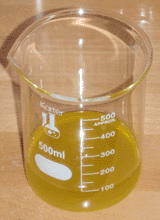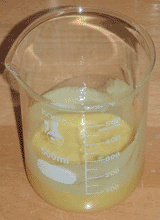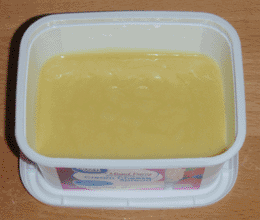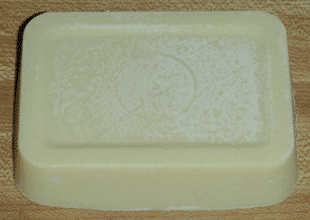



Different alkalis give soaps of different characteristics. While potassium hydroxide tends to yield soft, highly soluble soaps, sodium hydroxide produces the opposite, and has long been used to make ordinary bar soap. Since I use bar soap for bathing and nothing else, I decided to make a bar that was slightly rich in oil, so as to give it a moisturizing effect, and to potentially allow it to be used as shampoo as well.
I began by adding 30mL of water to a beaker, to which I added 10g of sodium hydroxide, all at once. The lower reactivity compared to potassium hydroxide and the higher ratio of water eliminated any risk of boiling, and the alkali dissolved without any issues, although it did produce an irritating vapor. Once this solution had cooled down, I then added 80g of olive oil, which formed a separate layer just as before. From this point, however, I decided to stir the mixture with a handheld blender (seen below), rather than a stirring rod. Early experiments revealed that sodium hydroxide has a much lower tendency to emulsify, even in more concentrated solutions, and no amount of manual stirring (upwards of four hours) produced a usable soap. Using a blender, however, I was able to produce a thick emulsion in less than thirty minutes. Once the mixture gained a batter-like consistency, I then poured it into a small plastic tub as a mold, which I had previously lubricated with olive oil to facilitate later removal of the soap bar. I then put the lid on the tub to retain moisture, and left it overnight for the reaction to complete.

The next day, I removed the soap from its mold and placed it in a warm location to dry and harden. After four days it seemed hard enough to be used, and can be seen at the top right of the page. Some sodium carbonate had formed on the surface due to atmospheric carbon dioxide, but this easily washed off with water. The soap was effective on both skin and hair, and the excess oil was moisturizing without being excessively greasy. Furthermore, the soap held its shape well when wet, which was surprising considering the fairly short cure time.
Overall this soap was very easy to make, and like the previous soap the ratio of ingredients is simple enough to remember (3:1:8 by weight). The use of a handheld blender significantly improved the process as well, and this could likely be transferred back to the previous recipe to shorten the preparation time. In general I am very pleased with the results here, and will likely continue to make this type of soap for personal use.
Despite the fact that this soap was usable after four days of drying, I found that it became soft after two days of use. Letting the soap dry for a further two weeks eliminated this problem, and it is now stable in water. My assumption is that the soap needs to be dry throughout, and that a wet center allows for rapid water permeation of the entire bar. From now on, I will dry the soap I make for one month before use.
I have also found that if less water is used, the blending process can be shortened to less than a minute; a successful batch of soap was made with this modification, having a weight ratio of 2:1:8 for water, sodium hydroxide, and olive oil respectively, with a small amount of turpentine (0.1% by weight, or 3 drops per 100g of oil) added to the oil as a fragrance. Interestingly, this soap developed no deposits of sodium carbonate; this is likely due the faster overall reaction time, which leaves less free sodium hydroxide to react with atmospheric carbon dioxide.
EDIT: 6/15/2025Since olive oil is currently very expensive, it is important to note that many other oils can be substituted to produce an equivalent soap. The exact properties of the soap, however, depend on the nature of the fatty acids within the oils being used. In general, the detergent power of the soap is determined by the molecular weight of the fatty acids, with shorter acids producing more powerful soaps. Similarly, the hardness (insolubility) of the soap is determined by the degree of saturation, with highly saturated fats making highly insoluble soaps. These two variables can be estimated via the saponification value and iodine number of the oil ingredients, with the saponification value also being essential for calculating the amount of alkali needed to saponify a given quantity of oil. This value is typically given in terms of milligrams of potassium hydroxide per gram of oil, and can therefore be multiplied by 1.1 for commercial (90%) potassium hydroxide flakes, or by 0.7 for commercial (99%) sodium hydroxide pellets. More practically, although most oils will work with the original formula described above, an online soap calculator can be used to more accurately control the amount of excess oil, and to estimate the final properties of the soap.
Specifically, for hard (solid) soap, oils high in mono-unsaturated fats (e.g. olive, peanut, or sunflower oil) or saturated fats (e.g. lard or palm oil) are most useful; however, oils high in poly-unsaturated fats (e.g. soybean or linseed oil) can be used to produce a soft (liquid) soap, even using sodium hydroxide. Furthermore, if any solid or semi-solid oils (primarily composed of saturated fats) are used, they should be melted first (at roughly 60°C) to avoid an incomplete reaction. I have also found a number of minor improvements to soapmaking in general, which are as follows:
First, a stainless steel drill mixer should be used rather than an immersion blender, being more easily cleanable and providing a more controllable reaction due to the somewhat slower mixing speed. Next, the ratio of water to alkali can be decreased to 3:2 (a 40% solution) if needed, to hasten the thickening of soap made from liquid oils, which are often slow to react. This solution can also be prepared more pleasantly if ice-water is used, since this reduces the amount of irritating vapors produced. Finally, the turpentine used in the above recipe can be replaced with clove oil (at up to 0.1% of the oil weight), which is a powerful saponification catalyst. This has similar antiseptic properties to turpentine, but can be added dropwise to recover a batch of soap which is slow to thicken, or otherwise be added at the start if rapid thickening is desired. Clove oil is also a useful oxidation inhibitor and defoamer (though not enough to impede lathering), and is generally helpful to every property of soap. Further additives include essential oils for fragrance and pigments for color, at up to 1% by weight of the soap oils. These additives should of course be non-toxic and stable in alkaline solutions, and for pigments specifically, I have found that iron oxides and ultramarine provide a full range of color while remaining chemically stable and entirely harmless.